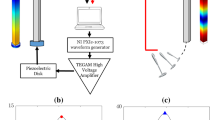Abstract
In this paper, a new application of resonant acoustic spectroscopy (RAS) is examined for constructing asphalt concrete mastercurves from seismic testing. The frequency-dependent material properties can be characterized from multiple modes of vibration through the use of RAS. Beam-shaped asphalt specimens are tested at multiple temperatures to determine the resonance frequencies of the specimens. The resonance frequencies are estimated by applying a small load impulse and measuring the resulting acceleration through the specimens. Using RAS, the material properties of the specimens are determined numerically using the measured resonance frequencies. The results presented show that the frequency-dependent dynamic modulus of the asphalt concrete specimens can be characterized using several modes of vibration at each testing temperature.
















Similar content being viewed by others
References
American Association of State Highway and Transportation Officials (AASHTO) (2007) Standard method of test for determining dynamic modulus of hot-mix asphalt mixtures. AASHTO Designation: TP 62, Washington
ASTM C215-08 Standard Test Method for Fundamental transverse, longitudinal, and torsional frequencies of concrete specimens. American Society for Testing and Materials (ASTM), New York
ASTM E 1876-99, Standard test method for dynamic Young’s modulus, shear modulus, and Poisson’s ratio by impulse excitation of vibration. American Society for Testing and Materials (ASTM), New York
Chen J, Pan T, Huang X (2011) Numerical investigation into the stiffness anisotropy of asphalt concrete from a microstructural perspective. Constr Build Mater. doi:10.1016/j.conbuildmat.2011.01.002
Di Benedetto H, Des Croix P (1996) Binder-mix rheology: limits of linear domain, non linear behavior. In: Eurasphalt & Eurobitume congress, Strasbourg, 7–10 May 1996
Di Benedetto H, Sauzéat C, Sohm J (2009) Stiffness of bituminous mixtures using ultrasonic wave propagation. Road Mater Pavement Des 10(4):789–814
Dongre R, Myers L, D’Angelo J, Paugh C, Gudimettla J (2005) Field evaluation of Witczak and Hirsch models for predicting dynamic modulus of hot–mix asphalt, vol 74, pp 381–442. Association of Asphalt Paving Technologists, Long Beach
NCHRP Guide for Mechanistic-Empirical Design (2004) Final Report, Part 2. Design inputs, chap 2. Material Characterization, NCHRP, March 2004
Hochuli AS, Sayir MB, Poulikakos LD, Partl MN (2001) Measuring the complex modulus of asphalt mixtures by structural wave propagation. Association of Asphalt Paving Technologists (AAPT), Clearwater Beach, 19–21 March 2001
Kweon G, Kim YR (2006) Determination of the complex modulus of asphalt concrete using the impact resonance test. J Transp Res Board 1970:151–160
Lacroix A, Kim YR, Far MSS (2009) Constructing the dynamic modulus mastercurve using impact resonance testing. Association of Asphalt Paving Technologists (AAPT)
Lebedev AV, Ostrovskiĭ LA, Sutin AM, Soustova IA, Johnson PA (2003) Resonant acoustic spectroscopy at low Q factors. Acoust Phys 49(1):81–87
Levenberg E (2006) Constitutive Modeling of asphalt-aggregate mixes with damage and healing. PhD dissertation, Technion, Israel Institute of Technology
Madigosky WM, Lee GF (1979) Automated dynamic Young’s modulus and loss factor measurements. Naval Surface weapons Center, White Oak, Silver Spring
Migliori A, Sarrao JL (1997) Resonant ultrasound spectroscopy—applications to physics, materials measurements and nondestructive evaluation. Wiley-Interscience, New York, ISBN 0-471-12360-9
Nazarian S, Yuan D, Tandon V, Arellano M (2005) Quality management of flexible pavement layers with seismic methods. Center for Transportation Infrastructure Systems, Research Report 0-1735-3, The University of Texas at El Paso
Norambuena-Contreras J, Catsro-Fresno D, Vega-Zamanillo A, Celaya M, Lombillo-Vozmediano I (2010) Dynamic modulus of asphalt mixture by ultrasonic direct test. NDT&E Int 43:629–634
Ostrovsky L, Lebedev A, Matveyev A, Potapov A, Sutin A, Soustova I, Johnson P (2001) Application of three-dimensional resonant acoustic spectroscopy method to rock and building materials. Acoust Soc Am 110:1770–1777
Ryden N (2011) Resonant frequency testing of cylindrical asphalt samples. Eur J Environ Civ Eng 15:587–600
SS-EN 12697-26:2004, Bituminous mixtures—test methods for hot mix asphalt—part 26: Stiffness, ICS 93.080.20
VVTBT (2009) Bitumenbundna lager 09, Publikation 2009:140, Vägverket
Whitmoyer SL, Kim YR (1994) Determining asphalt concrete properties via the impact resonant method. J Test Eval 22(2):139–148
Williams ML, Landel RF, Ferry JD (1955) The temperature dependence of relaxation mechanisms in amorphous polymers and other glass-forming liquids. J Am Chem Soc 77:3701–3707
Acknowledgments
The authors would like to thank the Swedish Transport Administration (Trafikverket) and the Swedish construction industry’s organization (SBUF) for their financial support. A great appreciation is also given to Olof Åkesson and Viktor Pettersson at Peab Asfalt’s laboratory in Helsingborg for their support in producing and testing the specimens.
Author information
Authors and Affiliations
Corresponding author
Rights and permissions
About this article
Cite this article
Gudmarsson, A., Ryden, N. & Birgisson, B. Application of resonant acoustic spectroscopy to asphalt concrete beams for determination of the dynamic modulus. Mater Struct 45, 1903–1913 (2012). https://doi.org/10.1617/s11527-012-9877-3
Received:
Accepted:
Published:
Issue Date:
DOI: https://doi.org/10.1617/s11527-012-9877-3




